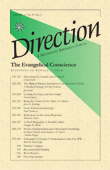Fall 2006 · Vol. 35 No. 2 · pp. 316–17
Book Review
Viewing New Creations with Anabaptist Eyes: Ethics of Biotechnology
ed. Roman J. Miller, Beryl H. Brubaker, and James C. Peterson. Telford, PA: Cascadia, 2005. 308 pages.
This book is based on presentations given at the conference, “Ethics of Biotechnology: Viewing New Creations with Anabaptist Eyes,” held at Eastern Mennonite University in November of 2003. The text is divided into three parts: Genetic Modifications, Perspectives, and Critique and Synthesis. At the end of part 1 and of part 2 are audience questions with responses by members of the presenting panel.
Part 1 is formatted as a presentation/response section. Dr. John D. Gearhart and Dr. Leslie G. Biesecker give a cogent description of stem cell research/cloning and human genetic therapies, respectively; while Dr. Carol L. Cramer gives an insightful description for the potential of genetically modified plants. Laypersons will appreciate their clear and concise writing styles that integrate technological and biological terminology into an easy-to-read format. Responses to the scientific essays provided by Dr. James C. Peterson are presented in an ethical and theological framework through the lenses of Anabaptism.
Part 2 represents an interdisciplinary approach to issues in biotechnology. The essays represent such diverse fields as nursing—presented in “An Ethic of Caring” by Dr. Beryl H. Brubaker—to poetry, presented in “Biotechnology Through the Lens of the Poet’s Pen” by Professor Barbra R. Graber. For readers new to the Anabaptist tradition, Dr. Conrad G. Brunk’s essay effectively relates biotechnology to Anabaptist values. Additional essays focus on biotechnology as it influences farming, prenatal screening, family values, and public policy.
Part 3 presents a synthesis and constructive criticism of the various ideas presented at the conference. Two essays of note are “Anabaptist Eyes on Biotechnology,” by Dr. Stanley M. Hauerwas, and “Facing Biotechnology as an Alternative Community of Worship, Character, and Discernment,” by Dr. Joseph J. Kotva Jr. This section represents one of the major strengths of this text. The authors of the essays in this section do a phenomenal job of tying together and analyzing the essays from part 1 and part 2. This is an advantage to the reader, as it can be quite daunting to remember all of the points raised in the previous writings.
Viewing New Creations with Anabaptist Eyes is a compelling collection of short essays by a diverse body of Anabaptists and friends of Anabaptists. Unlike other collective works, the writing is uniformly well done. This work is special in that it views biotechnology from the perspective of Anabaptist Evangelical Christians. As one can imagine, the status of the human embryo was the subject of several essays. The Anabaptist principle of alleviating suffering has engendered, at least among some panel participants, a dichotomy between doing harm to a fetus to procure stem cells to help those with Parkinson’s, Alzheimer’s, etc., and saving the fetus and thus allowing persons to suffer (Kotva, 294). Though the status of the embryo was a recurrent theme in several writings, no author linked the embryo to the concept of imago Dei. This may be troubling to readers that hold an orthodox position.
I recommend this book to all Anabaptists who have an interest in biotechnology and bioethics.

